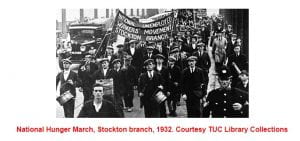In my previous post – https://foxburg.edublogs.org/2024/03/30/robert_traill_pt1/ I spoke about Robert Traill’s story before he arrived in Spain, this post tells the story of his career in Spain.
After my initial post Peter Verburgh commented :
the arrival of Robert Traill in the Paris International Brigade recruiting center caused some confusion – claiming to arrive from Moscow he was regarded as being somewhat suspicious by Maurice Tréand “Legros” of the Cadres Section of the French Communist Party, who was in charge of transporting International Brigade Volunteers and material aid across the border, and only after being verified and declared as bona fide he was allowed to proceed to Spain.
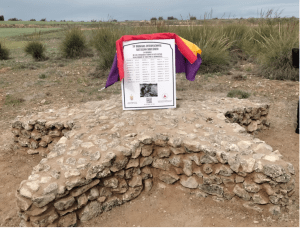 Due to the high number of casualties suffered by the XV International Brigade during the Jarama battles of February 1937 the General Staff of the Spanish Republican Army created the XX International Battalion. This mixed Battalion was made up of four companies: a Polish/Czechoslovak Company, a French Company, an Anglo-American Company which incorporated an Irish and British section, as well as a mixed machine-gun company of Germans and Austrians.
Due to the high number of casualties suffered by the XV International Brigade during the Jarama battles of February 1937 the General Staff of the Spanish Republican Army created the XX International Battalion. This mixed Battalion was made up of four companies: a Polish/Czechoslovak Company, a French Company, an Anglo-American Company which incorporated an Irish and British section, as well as a mixed machine-gun company of Germans and Austrians.
Robert was appointed to the XX International Battalion, as a Captain. the Commander was ‘Aldo Morandi’ the alias of the Italian Communist Riccardo Formica. Joe Monks, a fellow member of the XX International Battalion tells us:
Command of the Company went to Robert Traill, freshly out from Officers’ Training School who, without combat experience, was appointed Captain; but he was a linguist, having been a translator in Moscow. He was a Londoner originally. In Moscow he had married Miss V. Goutchoff and he was well informed on matters to do with the Soviet Union and Marxism. With the Reds in Andalusia by Joe Monks 1985
Robert’s skills as a linguist was utilised by the Battalion command:
Then Aldo Morandi, appointed Commander of our newly founded XX International Battalion, addressed us. He spoke in French and Captain Traill translated the address into English. I liked what I heard. The history of the International Battalions only went back to the previous October, but Morandi’s telling of their names and fame as a booster of morale rivaled the very best spirit that the Gaelic race distilled. With the Reds in Andalusia by Joe Monks 1985
*Amendment*
After speaking to Ray Hoff I have amended some of the text
Ray says: I don’t think that the XX Battalion went into Guadalajara. The Canadians in the XX Battalion report that they were sent south to the Cordoba front in February 1937. My understanding is that Traill and the guys in the photo of the ‘American Section’ (which includes the Canadian George Watt) were near Belalcazar, Hinejosa del Duque, Pozoblanco and Villanueva de Cordoba. You’ll have to look at Landis for a description of the fighting.
I think they were there until the end of May when the XX Battalion 2nd Company (Americans/Canadians/Brits) were sent back to Ambite where the Battalions were resting before Brunete.
A Cambridge graduate and an enigmatic figure, Traill had travelled to Spain directly from Moscow, where he had married a Russian named Vera, the daughter of a minister in the short-lived Kerensky government of 1917…Commander of a group of around 40 British and Irish volunteers who were training to form N°.1 section of the Anglo-American Company, part of the 20th Battalion…Robert Traill was described as showing excellent leadership. ‘You Are Legend’. The Welsh Volunteers in the Spanish Civil War, Graham Davies
Joe Monks tells us, that despite having limited officer training, and possibly some OTS from Oundle School, Robert competently led his company into battle:
Our Number Two Company, led by Traill, Dart, Daly and O’Daire, happily followed the textbook instructions, and by a process of plunging to earth as the shells were arriving, then rising with alacrity to run between the salvos, reached the glade in safety. We spread ourselves just below the crest of the green bank. With the Reds in Andalusia by Joe Monks. 1985
Joe Monks has nothing but praise for Robert:
Captain Traill moved from Section to Section on a quick check and then, in a composed way, continued to keep control from his command post. He performed excellently for a man who was experiencing his baptism in small arms fire. He had kept his cool, too, during the artillery bombardments. With the Reds in Andalusia by Joe Monks. 1985
In April 1937 the XX International Battalion was disbanded and the volunteers were reassigned to the 86th (Mixed) Brigade. As Commander of the 2nd Company of the XX International Battalion, Robert was promoted to the General Staff of the 86th Brigade as Chief of Staff of the Brigade, with Aldo Morandi the commander of the Brigade.
A part of Morandi’s diary entry for 25th April 1937 reads:
I can finally consider the general staff of the 86th mixed brigade constituted, a task to which I had dedicated myself since the 12th, even when I remained on the front line with the fighting troops. It is composed as follows:
Chief of Staff: Captain Traill of the 20th, English, speaks French well.
Head of 1st section: Lieutenant Röthing of the 20th, German, knows several languages.
2nd section manager: Lieutenant Mario De Castro del 14th, Portuguese, speaks French.
3rd section manager: the undersigned in charge of drawing up operation plans. Intendant manager: Lieutenant Josè Roballo of the 19th, Spanish.
Two corporals and eight soldiers taken from the 20th battalion complete the force; there are also the two guides. Aldo Morandi diary, with thanks to Peter Verburgh
Unfortunately Robert does not seem to happy in the 86th Brigade as shown below in Peter Verburgh’s translation of a note written by Aldo Morandi
The note comes from Peter’s post from exactly a year ago – from 2nd April 2023 – A short note about Robert Traill I think the translation speaks for itself.
As well as the British Battalion the XV Brigade contained the American Battalion commanded by Robert Merriman. Thanks to Ray Hoff we have Robert Merriman’s translated diaries in which he mentions Robert Traill on more than one occasion, most notably when he spent the night (and early morning) drinking with him:
Late session with boys & Traill, Bender & Bill and to bed late. Missed Vidal – just as well got more grenades. Stayed in Hotel. Boys Bill {Wheeler} and Lou slept in haystack. Merriman’s diary 7 Julio S. Fermín
The excuse for the drinking was possibly the Festival of San Fermin, which Merriman mentions, they may not have ran with the bulls but the XV International Brigade was about to face another test – the Battle of Brunete.
The XV International Brigade was part of a planned major Republican offensive designed to relieve pressure on the northern front.
On the 6th July, the British Battalion moved towards their objective, the heavily defended village of Villanueva de la Cañada, which Spanish Republican forces had been unable to secure. The battalion was pinned down by well-directed machine-gun fire, and forced to take cover, short of water and in temperatures of 40 degrees, and wait until nightfall. The village was captured eventually at midnight, though not before a number of volunteers were killed when Rebel soldiers attempted to escape by using civilians as human shields. https://international-brigades.org.uk/education/the-battle-of-brunete/
It was at Villanueva de la Cañada on 6th July 1937 that the Stockton volunteer Ron Dennison was killed, I have written about this in a previous blog – Ron Dennison
Records show that Robert Traill was killed on 7th July 1937 at Villanueva de la Cañada. As this is the date that the commander, Vladimir Ćopić, was wounded when attacked by German aircraft we might surmise that, as Robert was part of the Brigade Staff, he may well have been with him and was killed whilst Ćopić was wounded. Tragically just six days later Robert’s daughter Masha was born.
The news of his death was reported in the was reported in the Peterborough Standard.
Three weeks later Robert’s name appeared, with sixteen others, in the Daily worker as having ‘Died for Democracy’. Ironically I have only just found this page from the Daily Worker when researching Robert Traill. Frustratingly it confirms my research as once again Ron Dennison is shown as a Teesside Volunteer, this report is the first to give his home town as Stockton-on-Tees. Robert’s home address in this report is mistakenly given as Radyr, S Wales.
 Daily Worker, 29th July 1937 – page 4
Daily Worker, 29th July 1937 – page 4
Tom Wintringham had been expelled from the Communist Party in early 1938, but as the British Battalion arrived home after the withdrawal of the international Brigades he wrote to the Manchester Guardian in reply to slanderous accusations:
I have read with some surprise in a London paper that the International Brigades consisted of ‘the lowest dregs of the unemployed’ and of ‘Marxist hordes that desecrated churches’. The Manchester Guardian ,9th December 1938
It seems unlikely that Wintringham had much dealings with Robert; when Robert was in Spain Wintringham had spent four months in Hospital after being wounded on 13th February, and was then allocated to Albecete as an instructor, however he does mention him in this letter.
Our brigades have been called ‘international gunmen’. Let me run through names that seem strangely at variance with this and other labels stuck on us by those who choose to write without knowing the men they are writing about. Traill, a journalist from Bloomsbury, Chief of Staff of the 86th Brigade; Bee, our map-maker, an architect; David McKenzie, son of an admiral; Giles and Esmond Romilly, relatives of Winston Churchill; Malcolm Dunbar, son of Lady Dunbar, our last Chief of Staff of the Brigade; Hugh Slater, journalist, and very neat with his anti-tank guns; Clive Branson; Peter Whittaker; Ralph Bates, the novelist. The Manchester Guardian ,9th December 1938
Whilst in Moscow Robert had worked for the Comintern funded English-language paper Moscow News, which is why Wintringham saw him as a journalist
 Vera Trail, his widow was informed, and used solicitors with Moscow links, Bischoff, Coxe and Co, to administer his estate.
Vera Trail, his widow was informed, and used solicitors with Moscow links, Bischoff, Coxe and Co, to administer his estate.
 Robert is named on the Burry Port International Brigade memorial which is in the Burry Port Memorial Hall, Burry Port, Llanelli, Wales. The plaque was unveiled on 27th February 1997 by International Brigade volunteer Evan Jones. We are still unable to discover why Robert is named on this memorial.
Robert is named on the Burry Port International Brigade memorial which is in the Burry Port Memorial Hall, Burry Port, Llanelli, Wales. The plaque was unveiled on 27th February 1997 by International Brigade volunteer Evan Jones. We are still unable to discover why Robert is named on this memorial.
I met with Masha and her daughter Georgia a few months ago, sharing with them the information I had so far uncovered. To be honest I though that was the end of this fascinating story, but I could not have been more wrong.
As I was about to go to bed on Friday 29th March 2024 I opened a one line email from my friend Ray Hoff:
Since you were interested in Traill, check out Fosa #305 at Fuencarral….
attached was a document from the Russian State Archive of Socio-Political History (RGASPI) ![]()
This was a page of a document dating back to 1937:
BURIAL SERVICE OF THE INTERNATIONAL BRIGADES.
List of the fallen Comrades of the different International Brigades, buried in the Brigade Cemetery, located in Fuencarral (Madrid).
 Ray had discovered that Robert Traill had been buried at the Fuencarral Cemetery, in Madrid. The document also gives his date of death as 12th July 1937, which leads us to assume that like Ćopić Robert was wounded in the attack on 7th July, but unlike Ćopić he succumbed to his wounds.
Ray had discovered that Robert Traill had been buried at the Fuencarral Cemetery, in Madrid. The document also gives his date of death as 12th July 1937, which leads us to assume that like Ćopić Robert was wounded in the attack on 7th July, but unlike Ćopić he succumbed to his wounds.
It appear that Robert was given an honourable burial in the Fuencarral cemetery, his grave will have been marked with plaque, as shown in the image above; although I suspect his name may have been misspelt as shown in the document.
Under Franco’s brutal dictatorship all graves and monuments to those who fought Fascism in Spain during the Civil War were desecrated and destroyed. In 1941, just two years after the Fascist victory, the remains of Robert Trail with those of the other 450 Republican fighters in the Fuencarral cemetery were excavated from the cemetery and thrown into an unmarked mass grave. The graves and memorial plaque you see in the above pictures were destroyed.
It was not until after the death of Franco, in 1975, that Spaniards could openly commemorate the Republican dead. One of the first was the council in Madrid who unveiled a monument, in 1981, at the Fuencarral cemetery in honour of the of the International Brigaders buried there, it would become one of the most important sites of Republican memory in Spain.
On 28th and 29th of October 2016 the Asociación de Amigos de las Brigadas Internacionales (AABI) commemorated the 80th anniversary of the arrival of the first groups of International Brigades with events and gatherings in places significant to the battles against Franco’s fascists. On 28th October 2016 the delegations arrived at the Fuencarral Cemetery, in the northern part of Madrid, where the remains of some 451 International Brigaders are buried, with commemorative and memorial plaques placed from their countries of origin. A new plaque, commemorating 80 years since their arrival, was placed, https://international-brigades.org.uk/news-and-blog/content-madrid-remembers-international-brigades-80-years/
 In August 2017 the discovery of a mass grave brought a halt to renovation work at the Fuencarral Cemetery. The AABI in Spain, with the support of International Brigade associations around the world called for an examination of the site, believing this was the mass grave containing the remains of the International Brigade volunteers buried there in 1941.
In August 2017 the discovery of a mass grave brought a halt to renovation work at the Fuencarral Cemetery. The AABI in Spain, with the support of International Brigade associations around the world called for an examination of the site, believing this was the mass grave containing the remains of the International Brigade volunteers buried there in 1941.
Just two months ago, at the end of January 2024, an international outcry, led by Luis González, forced the Madrid city authorities to pause their plans to build a rubbish depot on top of the site of the mass grave.
I am grateful to a huge number of people, especially Ray Hoff, Peter Verburgh and Alan Warren who give so much valuable support and guidance, but I must primarily thank Masha for firstly entrusting me with her family history and then continuing to support me in my research, it is a deep and lasting honour to work on Robert’s story.
We commemorated Robert Traill during our 2023 Volunteers for Liberty event, when I spoke about his service in Spain. We will continue to remember Robert as a North East Volunteer for Liberty and we will ensure that he is also remembered at events held in Spain, especially those held in the Fuencarral Cemetery.
Rest in peace Robert Traill.


 The American section of 20th International Battalion, Possibly Robert Traill standing first from the right
The American section of 20th International Battalion, Possibly Robert Traill standing first from the right

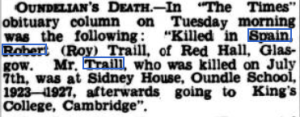



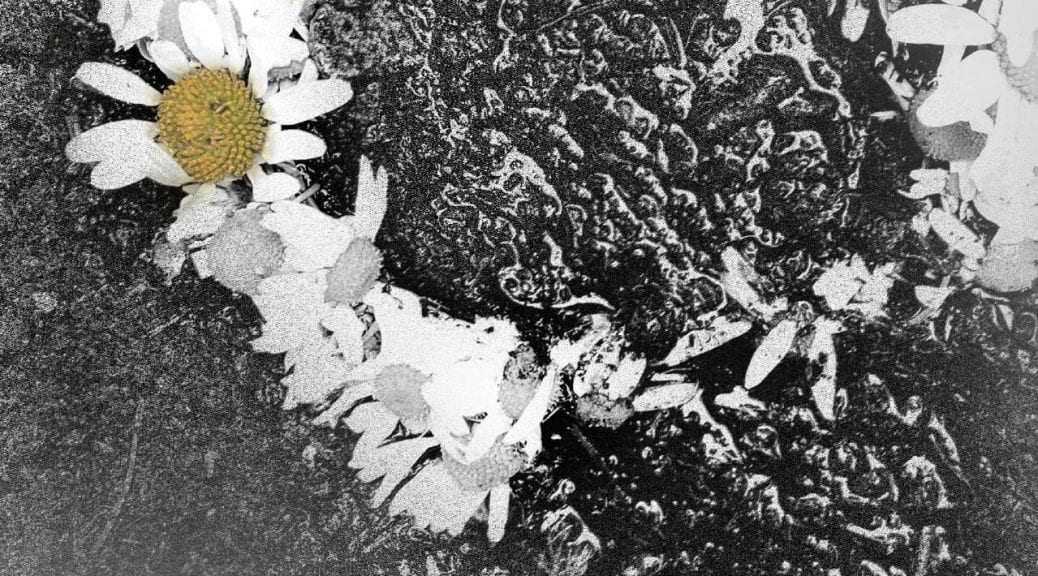











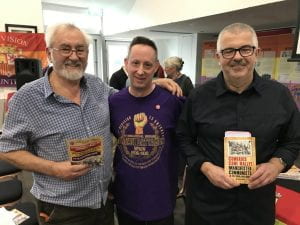

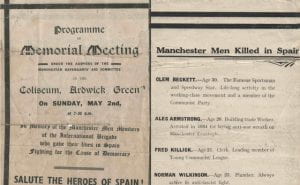

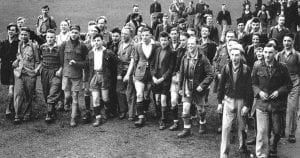



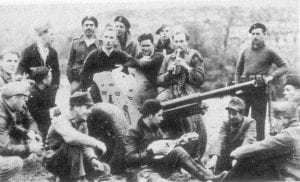
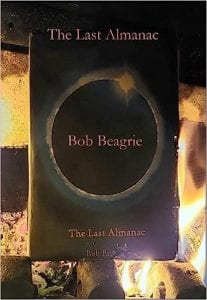



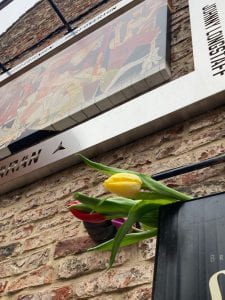













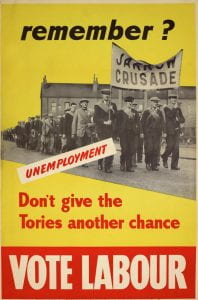
 Councillor David Riley
Councillor David Riley












